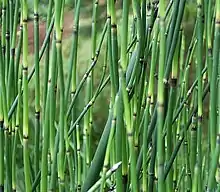| Equisetum giganteum | |
|---|---|
 | |
| Scientific classification | |
| Kingdom: | Plantae |
| Clade: | Tracheophytes |
| Division: | Polypodiophyta |
| Class: | Polypodiopsida |
| Subclass: | Equisetidae |
| Order: | Equisetales |
| Family: | Equisetaceae |
| Genus: | Equisetum |
| Subgenus: | E. subg. Hippochaete |
| Species: | E. giganteum |
| Binomial name | |
| Equisetum giganteum | |
| Synonyms[2] | |
| |
Equisetum giganteum, with the common name southern giant horsetail, is a species of horsetail native to South America and Central America, from central Chile east to Brazil and north to southern Mexico.
Description
It is one of the largest horsetails, growing 2–5 metres (6.6–16.4 ft) tall, exceeded only by the closely allied Equisetum myriochaetum (up to 8 metres (26 ft) relying on surrounding plants' support. One forma or variety has reached a height of thirtysix feet (eleven meters) in Venezuela,[3] and a height of 39 feet (twelve meters) in the Pantanal region of Brazil.[4] The stems are the stoutest of any horsetail, 1–2 cm diameter (up to 3.5 cm (1.33 inches) in diameter in some populations),[5] and bear numerous whorls of very slender branches; these branches are not further branched, but some terminate in spore cones. Unlike some other horsetails, it does not have separate photosynthetic sterile and non-photosynthetic spore-bearing stems.
Populations from northern Chile with very stout stems up to 3.5 cm diameter have sometimes been treated as a separate species Equisetum xylochaetum,[6] but this is not widely regarded as distinct. The thickest specimen to be reported by a trained botanist is 1.57 inches (four centimeters) by Dr. Thomas Schoepke on the Lluta River near Arica, Chile circa 1999–2000.[7][8]
References
- ↑ Christenhusz, M. (2019). "Equisetum giganteum". IUCN Red List of Threatened Species. 2019: e.T156392750A83689185. doi:10.2305/IUCN.UK.2019-3.RLTS.T156392750A83689185.en. Retrieved 20 December 2022.
- ↑ Tropicos.org, retrieved 5 January 2016
- ↑ Botting-Hemsley, W. (1888). Biologica Centrali-Americana - Botany - Volume 3. London: R.H. Porter and DuLau & Co. p. 699.
- ↑ Decker, Joao S. (1936). Aspectos Biologicos da Flora Brasileira. Sao Leopoldo, Brazil: Rottermund & Co. p. 538.
- ↑ Husby, Chad. "How large Can Giant Equisetum Become?". Retrieved August 25, 2004.
- ↑ Equisetum xylochaetum at Flora Brasiliensis online
- ↑ Correspondence with Equisetum specialist Chad Husby of Florida international University.
- ↑ Husby, Chad (n.d.). Equisetum/HoeLarge.html "How Large can Giant Equisetum Become?". Retrieved August 25, 2004.
{{cite web}}: Check|url=value (help)
External links
 Media related to Equisetum giganteum at Wikimedia Commons
Media related to Equisetum giganteum at Wikimedia Commons- fiu.edu: Giant Horsetails
- (in Portuguese) Lorenzi, H. & Souza, M. S. (2001). Plantas Ornamentais no Brasil: arbustivas, herbáceas e trepadeiras. Online ISBN 85-86714-12-7
